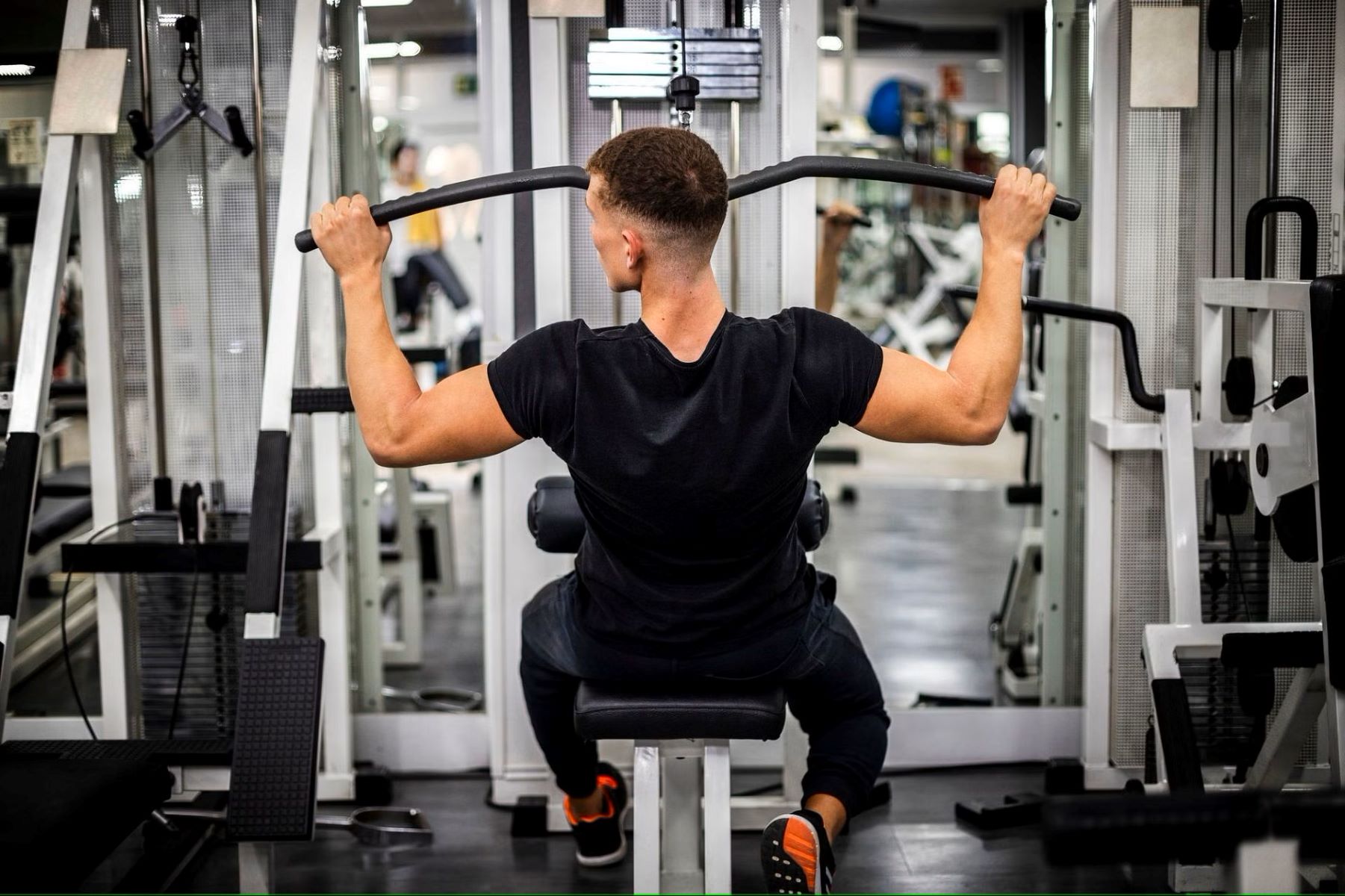Home>Health and Wellness>The Ultimate Guide To Lateral Raises: Unveiling The Secret To Sculpted Shoulders!


Health and Wellness
The Ultimate Guide To Lateral Raises: Unveiling The Secret To Sculpted Shoulders!
Published: January 21, 2024
Discover the ultimate guide to lateral raises for sculpted shoulders! Get expert tips and techniques for achieving your health and wellness goals.
(Many of the links in this article redirect to a specific reviewed product. Your purchase of these products through affiliate links helps to generate commission for Regretless.com, at no extra cost. Learn more)
Table of Contents
Introduction
Welcome to the ultimate guide to mastering one of the most effective shoulder sculpting exercises – the lateral raise. If you're looking to enhance your shoulder strength, improve posture, and achieve those coveted sculpted shoulders, you're in the right place. Lateral raises are a fundamental exercise that targets the deltoid muscles, helping to build definition and strength in the shoulders.
In this comprehensive guide, we will delve into the anatomy of the shoulders, uncover the myriad benefits of incorporating lateral raises into your workout routine, explore the proper form and technique to maximize results, and provide valuable tips for avoiding common mistakes. Additionally, we'll discuss various lateral raise variations and how to seamlessly integrate them into your existing workout regimen.
Whether you're a seasoned fitness enthusiast or just embarking on your fitness journey, understanding the intricacies of lateral raises and how to execute them with precision is crucial for achieving optimal results. By the end of this guide, you'll possess the knowledge and confidence to perform lateral raises effectively, ensuring that you're on the path to sculpted, well-defined shoulders.
So, let's embark on this enlightening journey and unlock the secrets to mastering lateral raises, paving the way for stronger, more sculpted shoulders and improved overall upper body strength. Let's dive in and discover the transformative power of this essential exercise!
Read more: 5 Unique Exercises To Replace Lateral Raises
Understanding the Anatomy of the Shoulders
The shoulders, also known as the deltoids, are a complex group of muscles that play a pivotal role in facilitating a wide range of upper body movements. Comprising three distinct heads – the anterior (front), lateral (middle), and posterior (rear) deltoids – this muscle group is responsible for shoulder abduction, flexion, and extension. Understanding the intricate anatomy of the shoulders is essential for comprehending the significance of lateral raises in targeting and strengthening these muscles.
The anterior deltoid is situated at the front of the shoulder and is primarily engaged in shoulder flexion, which involves raising the arms forward. It also contributes to horizontal shoulder adduction, assisting in movements such as hugging. The lateral deltoid, located on the side of the shoulder, is instrumental in shoulder abduction, enabling the arms to be lifted away from the body. Lastly, the posterior deltoid, located at the back of the shoulder, facilitates shoulder extension and horizontal shoulder abduction, allowing the arms to move backward and away from the body, respectively.
In addition to the deltoid muscles, the rotator cuff muscles, including the supraspinatus, infraspinatus, teres minor, and subscapularis, are integral to shoulder function and stability. These muscles work synergistically to support and stabilize the shoulder joint during various movements, emphasizing the importance of maintaining their strength and flexibility.
Furthermore, understanding the shoulder's intricate network of tendons, ligaments, and bursae is crucial for comprehending the vulnerability of this joint to injuries and the significance of targeted exercises, such as lateral raises, in fortifying its structural integrity.
By gaining a comprehensive understanding of the shoulder's anatomy, including its muscles, tendons, and supporting structures, individuals can develop a deeper appreciation for the pivotal role that lateral raises play in strengthening and sculpting this vital area. This knowledge forms the foundation for executing lateral raises with precision and purpose, ultimately leading to enhanced shoulder strength, stability, and aesthetics.
Benefits of Lateral Raises
Lateral raises are a highly effective exercise renowned for their myriad benefits, making them a valuable addition to any shoulder-focused workout routine. Let's explore the numerous advantages of incorporating lateral raises into your fitness regimen.
-
Targeted Deltoid Development: Lateral raises specifically target the lateral deltoid, aiding in the development of well-rounded, sculpted shoulders. By isolating this muscle group, lateral raises contribute to improved shoulder aesthetics and overall upper body strength.
-
Improved Shoulder Stability: Engaging in lateral raises helps enhance shoulder stability by strengthening the surrounding muscles and stabilizing the shoulder joint. This can be particularly beneficial for individuals who engage in activities that require overhead arm movements, such as weightlifting, swimming, or racquet sports.
-
Enhanced Functional Strength: Strong and well-developed shoulders are essential for performing everyday activities with ease and efficiency. Lateral raises contribute to improved functional strength, allowing individuals to engage in tasks such as lifting, carrying, and reaching with greater ease and reduced risk of injury.
-
Injury Prevention: By strengthening the deltoid muscles and improving overall shoulder stability, lateral raises can aid in the prevention of shoulder injuries. This is especially pertinent for individuals involved in repetitive overhead motions or those seeking to fortify their shoulders against potential strains and imbalances.
-
Shoulder Symmetry: Lateral raises play a pivotal role in promoting shoulder symmetry, ensuring balanced development of the anterior, lateral, and posterior deltoids. This balanced muscle development not only contributes to improved aesthetics but also supports optimal shoulder function and movement patterns.
-
Enhanced Posture: Strong and well-developed shoulders are integral to maintaining proper posture. Lateral raises help strengthen the muscles responsible for shoulder abduction, which can contribute to improved posture and reduced likelihood of slouching or rounded shoulders.
-
Versatility in Training: Lateral raises can be performed using various equipment, including dumbbells, resistance bands, or cable machines. This versatility allows individuals to tailor their workouts to their specific needs and preferences, making lateral raises accessible to individuals of all fitness levels.
-
Mind-Muscle Connection: Performing lateral raises requires a strong mind-muscle connection, encouraging individuals to focus on the targeted muscles and execute each repetition with precision. This heightened awareness can translate to improved overall training efficacy and muscle engagement.
Incorporating lateral raises into your workout routine can yield a multitude of benefits, ranging from aesthetic enhancements to functional improvements. By embracing this fundamental exercise, individuals can unlock the transformative potential of lateral raises, paving the way for stronger, more sculpted shoulders and improved overall upper body strength.
Proper Form and Technique
Executing lateral raises with proper form and technique is crucial for maximizing the effectiveness of this exercise while minimizing the risk of injury. By adhering to the following guidelines, individuals can ensure that they are targeting the lateral deltoid muscles effectively and reaping the full benefits of this fundamental shoulder exercise.
Body Positioning
- Stance: Begin by standing with your feet shoulder-width apart, maintaining a stable and balanced stance throughout the exercise. Engaging the core muscles will help stabilize the body and prevent excessive swaying or leaning.
- Posture: Maintain an upright posture with a slight bend in the knees. Avoid arching the back or excessively leaning forward, as this can place undue stress on the lower back and compromise form.
Execution
- Grip: Hold a dumbbell in each hand, allowing the arms to hang naturally by your sides with the palms facing inward.
- Initiation: With a controlled motion, raise the dumbbells to the sides until the arms are parallel to the floor. It is essential to initiate the movement from the shoulders, avoiding momentum generated by swinging the arms or using excessive body sway.
- Elbow Position: Keep a slight bend in the elbows throughout the movement to reduce strain on the joint and ensure that the tension remains on the deltoid muscles.
- Range of Motion: Aim for a smooth and controlled movement, lifting the dumbbells to shoulder height or slightly below. Avoid lifting the weights too high, as this may lead to unnecessary strain on the shoulder joint.
- Pause and Squeeze: At the top of the movement, pause momentarily and focus on contracting the lateral deltoids. This intentional squeeze enhances muscle engagement and maximizes the exercise's effectiveness.
- Lowering Phase: Lower the dumbbells back to the starting position in a controlled manner, resisting the urge to let gravity take over. Maintaining control during the lowering phase is essential for fully engaging the muscles and minimizing momentum.
Breathing
- Inhalation: Inhale as you raise the dumbbells, focusing on filling the lungs with air to support stability and control.
- Exhalation: Exhale as you lower the weights, maintaining a steady breathing rhythm throughout the exercise.
Common Mistakes to Avoid
- Excessive Weight: Avoid using excessively heavy weights that compromise form and lead to swinging or jerking motions. Focus on selecting a weight that allows for controlled and deliberate movements.
- Shrugging Shoulders: Refrain from elevating the shoulders toward the ears during the exercise, as this can shift the emphasis away from the lateral deltoids and increase the risk of neck and trap tension.
- Overarching the Back: Keep the back straight and avoid arching excessively to maintain proper spinal alignment and minimize strain on the lower back.
By adhering to these guidelines for proper form and technique, individuals can perform lateral raises with precision and intention, ensuring optimal engagement of the lateral deltoid muscles. Mastering the intricacies of this exercise empowers individuals to sculpt and strengthen their shoulders effectively, laying the foundation for enhanced upper body strength and aesthetics.
Common Mistakes to Avoid
When performing lateral raises, it's imperative to be mindful of common mistakes that can compromise the effectiveness of the exercise and increase the risk of injury. By recognizing and rectifying these errors, individuals can optimize their workout and ensure that the lateral deltoids are being targeted with precision. Let's delve into the specific mistakes to avoid when executing lateral raises:
Read more: The Ultimate Guide To Cage-Free, Free-Range, And Pasture-Raised Eggs: Unveiling The Hidden Truths!
Excessive Weight
One prevalent mistake is using weights that are excessively heavy, leading to compromised form and swinging motions. Selecting a weight that is too heavy can prompt individuals to rely on momentum rather than engaging the targeted muscles. This not only diminishes the effectiveness of the exercise but also increases the risk of strain and injury. It's essential to choose a weight that allows for controlled and deliberate movements, ensuring that the lateral deltoids are being adequately engaged throughout the entire range of motion.
Shrugging Shoulders
Another common error is the tendency to elevate the shoulders toward the ears during the execution of lateral raises. This unintended shrugging motion shifts the emphasis away from the lateral deltoids and places unnecessary strain on the neck and trapezius muscles. By consciously keeping the shoulders relaxed and avoiding upward shrugging, individuals can maintain the focus on the targeted muscles, maximizing the benefits of the exercise while minimizing tension in the neck and upper back.
Overarching the Back
Maintaining proper spinal alignment is crucial during lateral raises, yet many individuals inadvertently arch their backs excessively during the exercise. This can lead to strain on the lower back and compromise the integrity of the movement. By focusing on keeping the back straight and avoiding excessive arching, individuals can ensure that the lateral deltoids remain the primary focus of the exercise, promoting optimal muscle engagement and minimizing the risk of discomfort or injury.
By being mindful of these common mistakes and actively working to avoid them, individuals can perform lateral raises with precision and intention, maximizing the effectiveness of the exercise while safeguarding against potential pitfalls. Recognizing and rectifying these errors contributes to the overall efficacy of the workout, ensuring that the targeted muscles are being strengthened and sculpted effectively.
Variations of Lateral Raises
Variations of lateral raises offer an array of options to target the deltoid muscles from different angles and intensities, providing individuals with the flexibility to tailor their workouts to specific goals and preferences. By incorporating variations into their training regimen, individuals can effectively challenge the deltoids while promoting balanced muscle development and enhancing overall shoulder strength. Let's explore some key variations of lateral raises:
1. Dumbbell Lateral Raises
Dumbbell lateral raises are a classic variation that involves lifting dumbbells to the sides, focusing on isolating the lateral deltoids. This exercise can be performed while standing or seated, allowing for variations in body positioning to accommodate individual comfort and stability. By adjusting the weight and range of motion, individuals can customize the intensity of the exercise to suit their fitness level and training goals.
2. Cable Lateral Raises
Utilizing a cable machine for lateral raises introduces constant tension throughout the movement, providing a unique resistance profile compared to traditional dumbbell raises. The adjustable pulley system allows for precise control over the resistance, enabling individuals to target the lateral deltoids with a smooth and consistent load. Cable lateral raises are particularly effective for emphasizing the peak contraction of the deltoids, promoting enhanced muscle engagement and development.
3. Incline Lateral Raises
Performing lateral raises on an inclined bench introduces a novel challenge by altering the angle of the movement. This variation places greater emphasis on the lateral deltoids while engaging stabilizing muscles to a greater extent. The inclined position encourages a controlled and deliberate range of motion, fostering heightened muscle activation and promoting shoulder stability. Incline lateral raises offer a dynamic approach to targeting the deltoids, contributing to comprehensive shoulder development.
4. Reverse Flyes
While not a traditional lateral raise, reverse flyes are a valuable variation that targets the posterior deltoids and upper back muscles. By performing this exercise with dumbbells or a cable machine, individuals can effectively strengthen the rear deltoids while promoting balanced shoulder development. Incorporating reverse flyes into a shoulder workout routine complements lateral raises by addressing the often-neglected posterior deltoids, contributing to overall shoulder symmetry and strength.
5. Resistance Band Lateral Raises
Resistance band lateral raises offer a portable and versatile alternative to traditional weight-based exercises. The elastic resistance provided by bands challenges the lateral deltoids throughout the entire range of motion, promoting muscular endurance and stability. This variation is particularly beneficial for individuals seeking a convenient and adaptable training option, as resistance bands can be easily incorporated into home workouts or utilized for on-the-go training.
By integrating these variations into their training repertoire, individuals can diversify their shoulder workouts, effectively targeting the deltoids from multiple angles while promoting balanced muscle development. Each variation offers unique benefits, catering to different preferences and training objectives. Whether aiming to enhance shoulder aesthetics, improve functional strength, or prevent imbalances, the diverse array of lateral raise variations empowers individuals to optimize their shoulder training with tailored and effective exercises.
Incorporating Lateral Raises into Your Workout Routine
Incorporating lateral raises into your workout routine can significantly contribute to comprehensive shoulder development and overall upper body strength. Whether you're a seasoned fitness enthusiast or a beginner on your fitness journey, strategically integrating lateral raises can yield transformative results. Here's a detailed insight into seamlessly infusing this essential exercise into your workout regimen.
Frequency and Volume
When incorporating lateral raises into your routine, it's essential to strike a balance between frequency and volume. Aim to perform lateral raises 2-3 times per week, allowing for adequate recovery between sessions. Consider incorporating them into both upper body and shoulder-focused workouts to ensure consistent stimulation of the deltoid muscles. Start with 3-4 sets of 10-15 repetitions, focusing on controlled and deliberate movements to maximize muscle engagement.
Pre-Exhaust or Activation
Incorporating lateral raises as a pre-exhaust or activation exercise can effectively prime the deltoid muscles before engaging in compound movements such as overhead presses or upright rows. Performing a set of lateral raises with moderate intensity prior to engaging in heavier shoulder exercises can enhance the mind-muscle connection and ensure that the lateral deltoids are adequately activated, promoting optimal engagement during subsequent compound movements.
Read more: The Ultimate Guide To Finding Your Dream Cream Dachshund: Unveiling The Secrets To Success!
Superset or Tri-set Combinations
Integrating lateral raises into superset or tri-set combinations can add a dynamic element to your workout routine while promoting muscular endurance and metabolic stress. Pairing lateral raises with complementary exercises, such as front raises, upright rows, or shoulder presses, allows for efficient utilization of time and resources while promoting comprehensive shoulder development. This approach can also contribute to an elevated training stimulus, fostering increased muscle recruitment and promoting overall shoulder strength.
Progressive Overload
To ensure continual progress and adaptation, it's essential to implement progressive overload when incorporating lateral raises into your workout routine. Gradually increasing the resistance, volume, or intensity of the exercise over time can promote ongoing muscle development and strength gains. Whether through the use of heavier weights, increased repetitions, or advanced variations, progressive overload is integral to fostering sustained improvements in shoulder strength and aesthetics.
Mind-Muscle Connection
Emphasizing the mind-muscle connection during lateral raises is paramount for maximizing the effectiveness of the exercise. Focusing on intentional muscle contractions and maintaining strict form throughout each repetition can significantly enhance the engagement of the lateral deltoids, ultimately contributing to targeted muscle development and improved training efficacy. Cultivating a strong mind-muscle connection during lateral raises is key to reaping the full benefits of this fundamental shoulder exercise.
By strategically incorporating lateral raises into your workout routine with careful attention to frequency, volume, and exercise combinations, individuals can effectively target and strengthen the deltoid muscles, ultimately contributing to enhanced shoulder aesthetics and functional strength. Whether aiming to sculpt well-defined shoulders, improve shoulder stability, or promote balanced muscle development, the seamless integration of lateral raises can pave the way for transformative results in your fitness journey.
Tips for Maximizing Results
When striving to maximize the results of your lateral raise workouts, incorporating strategic tips and techniques can significantly enhance the effectiveness of this fundamental shoulder exercise. By implementing the following guidelines, individuals can optimize their training approach, foster targeted muscle development, and unlock the full potential of lateral raises.
1. Focus on Mind-Muscle Connection
Cultivating a strong mind-muscle connection during lateral raises is paramount for maximizing results. By consciously engaging and contracting the lateral deltoids throughout each repetition, individuals can ensure that the targeted muscles are being effectively stimulated. Focusing on the sensation of the muscles at work can enhance muscle recruitment and promote optimal muscle engagement, contributing to improved strength and definition in the shoulders.
2. Emphasize Controlled and Deliberate Movements
Executing lateral raises with controlled and deliberate movements is essential for maximizing results. Avoiding momentum-driven motions and instead focusing on smooth and intentional lifts and descents can enhance the effectiveness of the exercise. By prioritizing controlled movements, individuals can ensure that the lateral deltoids are bearing the brunt of the workload, promoting targeted muscle development and minimizing the risk of injury.
3. Gradually Increase Resistance and Intensity
Implementing progressive overload by gradually increasing the resistance and intensity of lateral raises is instrumental for maximizing results. Whether through the use of heavier weights, increased repetitions, or advanced variations, progressive overload fosters ongoing muscle adaptation and strength gains. By progressively challenging the muscles, individuals can stimulate continual growth and development in the shoulders, ultimately contributing to enhanced strength and aesthetics.
4. Prioritize Proper Form and Technique
Maintaining proper form and technique throughout each set of lateral raises is crucial for maximizing results. By adhering to the recommended body positioning, execution guidelines, and breathing patterns, individuals can ensure that the lateral deltoids are being effectively targeted without placing undue strain on other muscle groups or joints. Prioritizing proper form promotes optimal muscle engagement and reduces the risk of injury, ultimately contributing to sustained progress and results.
5. Implement Variability in Training
Incorporating a variety of lateral raise variations into your training regimen can promote comprehensive shoulder development and prevent plateaus. By engaging in different variations, such as incline lateral raises, cable lateral raises, or resistance band lateral raises, individuals can target the deltoid muscles from various angles and intensities. This variability challenges the muscles in diverse ways, promoting balanced muscle development and preventing adaptation, ultimately maximizing the effectiveness of shoulder workouts.
6. Ensure Adequate Recovery and Nutrition
Prioritizing adequate rest and recovery between lateral raise workouts is essential for maximizing results. The muscles require time to repair and grow, making proper recovery integral to the muscle-building process. Additionally, ensuring proper nutrition, including adequate protein intake and overall nutrient balance, supports muscle recovery and growth, ultimately contributing to optimized results from shoulder training.
By integrating these tips into your lateral raise workouts, you can effectively maximize the results of this essential shoulder exercise. Focusing on the mind-muscle connection, emphasizing controlled movements, implementing progressive overload, prioritizing proper form, incorporating training variability, and ensuring adequate recovery and nutrition collectively contribute to enhanced shoulder strength, aesthetics, and overall training efficacy.
Conclusion
In conclusion, mastering the art of lateral raises is a transformative endeavor that holds the key to sculpted shoulders, enhanced upper body strength, and improved shoulder stability. Through a comprehensive understanding of the shoulder's anatomy, including the intricate network of deltoid muscles and supporting structures, individuals can appreciate the pivotal role that lateral raises play in targeting and strengthening this vital area. By adhering to proper form and technique, avoiding common mistakes, and embracing a variety of lateral raise variations, individuals can effectively challenge and stimulate the deltoid muscles, ultimately contributing to comprehensive shoulder development.
The benefits of incorporating lateral raises into a workout routine are multifaceted, ranging from targeted deltoid development and improved shoulder stability to enhanced functional strength and injury prevention. By embracing this fundamental exercise, individuals can unlock the transformative potential of lateral raises, paving the way for stronger, more sculpted shoulders and improved overall upper body strength.
Strategic integration of lateral raises into a workout routine, coupled with a focus on mind-muscle connection, controlled movements, progressive overload, and exercise variability, can significantly enhance the effectiveness of shoulder workouts. Prioritizing proper form and technique, avoiding common mistakes, and ensuring adequate recovery and nutrition further contribute to optimized results from lateral raise training.
In essence, the journey to mastering lateral raises is a dynamic and rewarding pursuit that empowers individuals to sculpt and strengthen their shoulders effectively. Whether striving for aesthetic enhancements, improved functional strength, or injury prevention, the seamless integration of lateral raises into a workout routine holds the potential to yield transformative results. By embracing the principles and techniques outlined in this guide, individuals can embark on a path toward well-defined shoulders, enhanced upper body strength, and a newfound appreciation for the power of targeted shoulder training.








